Flag Football hat im Vergleich zu American Football nur eine geringe Anzahl von Regeln, allerdings sind diese für Personen die das erste Mal mit Flag Football zu tun haben nicht einfach zu verstehen.
Die Regeln können hier nachgelesen werden:
Das internationale Flag Football Regelwerk von 2019.
| Sprachen: | English |
| Autor: | Wolfgang Geyer |
| Kategorie: | Aktuelles Regelwerk |
| Datum: | October 16, 2019 |
Hat man sich mit diesen auseinander gesetzt, gibt es die Möglichkeit das Gelernte in einem kleinen Test unter Beweis zu stellen:
Regelquiz Flag Football für Beginner
Quiz-Zusammenfassung
0 von 16 Fragen beantwortet
Fragen:
- 1
- 2
- 3
- 4
- 5
- 6
- 7
- 8
- 9
- 10
- 11
- 12
- 13
- 14
- 15
- 16
Informationen
|
Sie müssen eine E-Mail Adresse angeben. |
|
|
Sie müssen dieses Feld ausfüllen. |
Informationen
Ein Quiz das sich mit den grundlegenden Regeln von Flag Football beschäftigt und sich gut für Einsteiger eignet.
Ablauf des Quiz:
- bei Multiple-Choice-Antworten gibt es nur eine richtige Antwort
- die Fragen und Antworten werden mit jedem Start neu gemischt
- für die Statistiker gibt es am Ende des Quiz ein Leaderboard
- Feedback kann gerne am Ende des Quiz abgegeben werden
Sie haben das Quiz schon einmal absolviert. Daher können sie es nicht erneut starten.
Quiz wird geladen...
Sie müssen sich einloggen oder registrieren um das Quiz zu starten.
Sie müssen erst folgende Quiz beenden um dieses Quiz starten zu können:
Ergebnis
0 von 16 Frage korrekt beantwortet
Ihre Zeit:
Zeit ist abgelaufen
Sie haben 0 von 0 Punkten erreicht (0)
| Ø Punkte |
|
| Deine Punkte |
|
Kategorien
- Nicht kategorisiert 0%
- spielablauf 0%
| Platz | Name | Eingetragen am | Punkte | Ergebnis |
|---|---|---|---|---|
| Tabelle wird geladen | ||||
| Keine Daten verfügbar | ||||
- 1
- 2
- 3
- 4
- 5
- 6
- 7
- 8
- 9
- 10
- 11
- 12
- 13
- 14
- 15
- 16
- Beantwortet
- Vorgemerkt
-
Frage 1 von 16
1. Frage
Was passiert, wenn ein Team nach dem 4. Versuch nicht den Firstdown geschafft hat?
Korrekt
Inkorrekt
-
Frage 2 von 16
2. Frage
Das Team startet ihren Angriff an …
Korrekt
Inkorrekt
-
Frage 3 von 16
3. Frage
Bei einem 4. Versuch hat das angreifende Team die Möglichkeit:
Korrekt
Inkorrekt
-
Frage 4 von 16
4. Frage
Nach einer Interception, außerhalb der Endzone, wird der Ball an folgende Stelle gelegt:
Korrekt
Inkorrekt
-
Frage 5 von 16
5. Frage
Wenn ein Team weniger als 5 Spieler hat, z.B. aufgrund von Verletzungen, wird das Spiel
Korrekt
Inkorrekt
-
Frage 6 von 16
6. Frage
Nach dem ein Team einen Touchdown erzielt hat …
Korrekt
Inkorrekt
-
Frage 7 von 16
7. Frage
Das angreifende Team darf während des 4. Versuchs entscheiden, ob sie punten wollen.
Korrekt
Inkorrekt
Beim Flag Football ist ein Punt oder Kick des Balls generell nicht erlaubt.
-
Frage 8 von 16
8. Frage
Um zu punkten, muss sich der Ballträger komplett in der Endzone befinden.
Korrekt
Die Ballspitze muss sich auf Höhe der Endzone-Linie befinden, damit Punkte erzielt werden. Der Spieler ist dabei unerheblich.
Inkorrekt
Die Ballspitze muss sich auf Höhe der Endzone-Linie befinden, damit Punkte erzielt werden. Der Spieler ist dabei unerheblich.
-
Frage 9 von 16
9. Frage
Wenn ein Offense-Spieler mit Ball in seiner eigenen Endzone deflaggt (Flagge gezogen) wird, dann wird dies als Safety gewertet.
Korrekt
Inkorrekt
-
Frage 10 von 16
10. Frage
Wie ist die korrekte Zuordnung der Punkte?
Sortierelemente
- 6 Punkte
- 1 Punkt
- 2 Punkte
- 2 Punkte
-
Touchdown
-
Extra-Punkt-Versuch
-
Safety
-
Zwei-Punkte-Versuch
Korrekt
Inkorrekt
Die richtige Lösung ist:
- Touchdown: 6 Punkte
- Safety: 2 Punkte
- Extra-Punkt-Versuch: 1 Punkt
- Zwei-Punkte-Versuch: 2 Punkte
-
Frage 11 von 16
11. Frage
Wie viele Versuche hat die Offense maximal, um die Mittellinie zu überqueren?
Korrekt
Inkorrekt
-
Frage 12 von 16
12. Frage
Ein Spielzug startet und endet immer mit einem Pfiff.
Korrekt
Inkorrekt
-
Frage 13 von 16
13. Frage
Eine nur “Pässe erlaubt”-Situation entsteht, wenn …
Korrekt
Inkorrekt
-
Frage 14 von 16
14. Frage
Zwischen zwei Spielern kommt es zu einem sichtlichen Körperkontakt mit Beeinflussung (z.B. Spieler wird geschubst / festgehalten) …
Korrekt
Körperkontakt ist beim Flag Football grundsätzlich verboten und wird mit einem Illegal Contact bestraft, d.h. 10-YD Strafe und automatischer erster Versuch.
Inkorrekt
Körperkontakt ist beim Flag Football grundsätzlich verboten und wird mit einem Illegal Contact bestraft, d.h. 10-YD Strafe und automatischer erster Versuch.
-
Frage 15 von 16
15. Frage
Eine Strafe wird beim Flag Football durch das Werfen einer gelben Flagge signalisiert.
Korrekt
Inkorrekt
-
Frage 16 von 16
16. Frage
Bei einer Strafe wird ein laufender Spielzug immer sofort abgepfiffen.
Korrekt
Die meisten Strafen sorgen nicht dafür, dass ein Spielzug sofort abgepfiffen wird. Am Ende eines Spielzugs hat das gefoulte Team die Möglichkeit die Strafe anzunehmen oder abzulehnen.
Inkorrekt
Die meisten Strafen sorgen nicht dafür, dass ein Spielzug sofort abgepfiffen wird. Am Ende eines Spielzugs hat das gefoulte Team die Möglichkeit die Strafe anzunehmen oder abzulehnen.
Regelquiz Flag Football für Fortgeschrittene
Quiz-Zusammenfassung
0 von 14 Fragen beantwortet
Fragen:
- 1
- 2
- 3
- 4
- 5
- 6
- 7
- 8
- 9
- 10
- 11
- 12
- 13
- 14
Informationen
|
Sie müssen eine E-Mail Adresse angeben. |
|
|
Sie müssen dieses Feld ausfüllen. |
Informationen
Ein Quiz für Schiedsrichter die bereits ihr erstes Spiel gepfiffen haben und sich mit den Regeln näher auseinander setzen möchten.
Ablauf des Quiz:
- bei Multiple-Choice-Antworten gibt es mindestens eine richtige Antwort
- die Fragen und Antworten werden mit jedem Start neu gemischt
- für die Statistiker gibt es am Ende des Quiz ein Leaderboard
- Feedback kann gerne am Ende des Quiz abgegeben werden
Sie haben das Quiz schon einmal absolviert. Daher können sie es nicht erneut starten.
Quiz wird geladen...
Sie müssen sich einloggen oder registrieren um das Quiz zu starten.
Sie müssen erst folgende Quiz beenden um dieses Quiz starten zu können:
Ergebnis
0 von 14 Frage korrekt beantwortet
Ihre Zeit:
Zeit ist abgelaufen
Sie haben 0 von 0 Punkten erreicht (0)
| Ø Punkte |
|
| Deine Punkte |
|
Kategorien
- Nicht kategorisiert 0%
| Platz | Name | Eingetragen am | Punkte | Ergebnis |
|---|---|---|---|---|
| Tabelle wird geladen | ||||
| Keine Daten verfügbar | ||||
- 1
- 2
- 3
- 4
- 5
- 6
- 7
- 8
- 9
- 10
- 11
- 12
- 13
- 14
- Beantwortet
- Vorgemerkt
-
Frage 1 von 14
1. Frage
Welche Bedingungen müssen erfüllt sein, damit ein Foul als Pass Interference (PI) gewertet wird?
Korrekt
10YD Strafe vom Basic Spot und automatischer 1. Versuch:
Pass interference is contact that interferes with an opponent whilst the ball is in the air. Rule 7 – Section 3 – Article 3
Sollte der Ball nicht fangbar sein, dann wird das Vergehen als Illegal Contact geahndet.Inkorrekt
10YD Strafe vom Basic Spot und automatischer 1. Versuch:
Pass interference is contact that interferes with an opponent whilst the ball is in the air. Rule 7 – Section 3 – Article 3
Sollte der Ball nicht fangbar sein, dann wird das Vergehen als Illegal Contact geahndet. -
Frage 2 von 14
2. Frage
Wo ist in der Regel der Basic Spot?
Korrekt
The basic spot is the scrimmage line.
Exceptions:- For offense fouls behind the scrimmage line, the basic spot is the spot of the foul.
- For defense fouls when the dead ball spot is beyond the scrimmage line, the basic spot is the dead ball spot.
- For fouls after a change of possession the basic spot will be the dead ball spot. Only if the foul is on the last related run from the team ending with possession and behind the dead ball spot, the basic spot is the spot of foul.
Rule 10 – Section 3 – Article 1
Inkorrekt
The basic spot is the scrimmage line.
Exceptions:- For offense fouls behind the scrimmage line, the basic spot is the spot of the foul.
- For defense fouls when the dead ball spot is beyond the scrimmage line, the basic spot is the dead ball spot.
- For fouls after a change of possession the basic spot will be the dead ball spot. Only if the foul is on the last related run from the team ending with possession and behind the dead ball spot, the basic spot is the spot of foul.
Rule 10 – Section 3 – Article 1
-
Frage 3 von 14
3. Frage
Die Offense wird in der gegnerischen Hälfte mit einem Illegal Contact (10YD Strafe und Wiederholung des Versuchs) gefoult. Der Spielzug ist an der gegnerischen +16 YD Linie beendet. Wo wird der Ball gespottet?
Korrekt
Von der +16YD Linie greift die Half-Distance Enforcement Regel, welche verhindert, dass eine Strafe ein Team näher als die Hälfte an die Endzone des Foul verursachenden Teams bringt.
No distance penalty, including tries, shall exceed half the distance from the enforcement spot to the offending team’s
goal line. Rule 10 – Section 3 – Article 3Inkorrekt
Von der +16YD Linie greift die Half-Distance Enforcement Regel, welche verhindert, dass eine Strafe ein Team näher als die Hälfte an die Endzone des Foul verursachenden Teams bringt.
No distance penalty, including tries, shall exceed half the distance from the enforcement spot to the offending team’s
goal line. Rule 10 – Section 3 – Article 3 -
Frage 4 von 14
4. Frage
Ein Offensespieler bewegt sich unmittelbar vor dem Snap. Was ist zu tun?
Korrekt
5YD Strafe von der Line of Scrimmage, es bleibt beim gleichen Versuch:
No offensive player shall make a false start or make a movement that simulates the beginning of a play. Rule 7 – Section 1 – Article 3cInkorrekt
5YD Strafe von der Line of Scrimmage, es bleibt beim gleichen Versuch:
No offensive player shall make a false start or make a movement that simulates the beginning of a play. Rule 7 – Section 1 – Article 3c -
Frage 5 von 14
5. Frage
Ein Offensespieler läuft seine Passroute, dabei muss der Blitzer mit Right of Way ausweichen, um einen Zusammenstoß zu verhindern. Der QB wird gesackt. Wo wird der Ball gespottet?
Korrekt
5YD Strafe und Wiederholung des Versuchs vom Basic Spot (in diesem Fall: Line of Scrimmage), wenn die Defense die Strafe akzeptiert. Beim Ablehnen der Strafe wird der Ball dort platziert, wo der QB gesackt wurde und es geht mit dem nächsten Versuch weiter:
Blocking is obstructing an opponent without contact by moving into his way. A moving offensive player who impedes
an opponent from getting to the runner or impedes a legal blitzer is guilty of blocking. A player standing still (with the
right of place) is not blocking, even if he is in between the runner and the opponent or in the way of a blitzer. Rule 2 – Section 11 – Article 2Inkorrekt
5YD Strafe und Wiederholung des Versuchs vom Basic Spot (in diesem Fall: Line of Scrimmage), wenn die Defense die Strafe akzeptiert. Beim Ablehnen der Strafe wird der Ball dort platziert, wo der QB gesackt wurde und es geht mit dem nächsten Versuch weiter:
Blocking is obstructing an opponent without contact by moving into his way. A moving offensive player who impedes
an opponent from getting to the runner or impedes a legal blitzer is guilty of blocking. A player standing still (with the
right of place) is not blocking, even if he is in between the runner and the opponent or in the way of a blitzer. Rule 2 – Section 11 – Article 2 -
Frage 6 von 14
6. Frage
Ein Defensespieler hechtet nach der Flagge, ohne den Runner zu berühren, und zieht diese. Wie ist dies zu bewerten?
Korrekt
Diving is an attempt by the runner to avoid a flag pull by the forward leaning the upper body, with or without jumping. Rule 2 – Section 12 – Article 2
Inkorrekt
Diving is an attempt by the runner to avoid a flag pull by the forward leaning the upper body, with or without jumping. Rule 2 – Section 12 – Article 2
-
Frage 7 von 14
7. Frage
Ordne die Schiedsrichter-Signale (Teil 1) richtig zu! (Bilder-Quelle: INTERNATIONAL FLAG FOOTBALL RULES 5 on 5 / non-contact 2015)
Sortierelemente
- Safety
- Ready for Play
- Firstdown
- False Start
- Illegal Contact
-
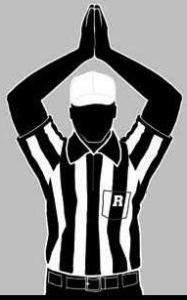
Referee Signal 6 -
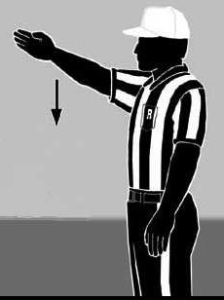
Referee Signal 1 -

Referee Signal 8 -
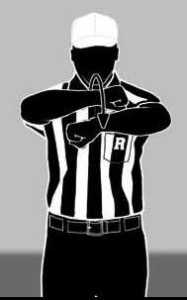
Referee Signal 19 -

Referee Signal 36
Korrekt
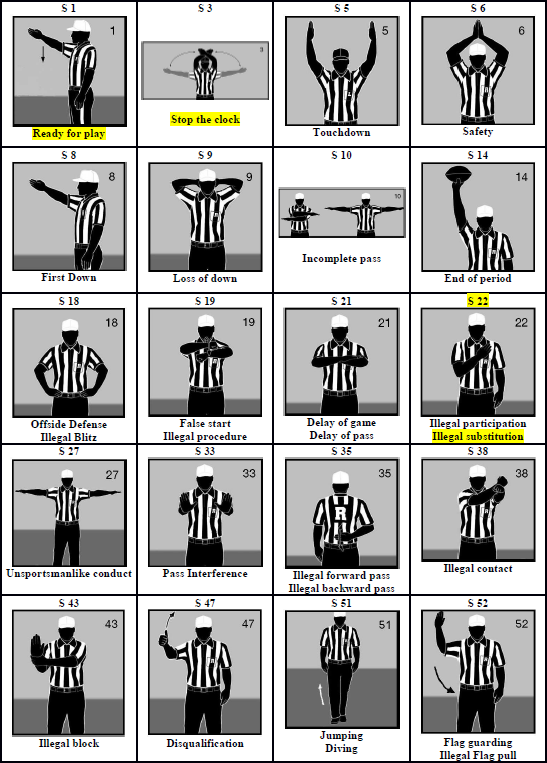 Inkorrekt
Inkorrekt

-
Frage 8 von 14
8. Frage
Was bedeutet Right of Place before Right of Way?
Korrekt
ARTICLE 1. Right of Place
Right of place is given to a standing player. Standing means to remain at the spot and make no lateral movement.
Jumping vertically in order to throw or catch a pass or pulling a flag whilst standing still does not give up the right of
place.
Right of place supersedes right of way when determining who is guilty of a foul.ARTICLE 2. Right of Way
Right of way is given to a player by rule who has established a direction of movement and does not alter that direction.
A player with Right of Way has a higher priority when determining who is guilty of committing a foul than all players
except those with right of place.Rule 2 – Section 13
Inkorrekt
ARTICLE 1. Right of Place
Right of place is given to a standing player. Standing means to remain at the spot and make no lateral movement.
Jumping vertically in order to throw or catch a pass or pulling a flag whilst standing still does not give up the right of
place.
Right of place supersedes right of way when determining who is guilty of a foul.ARTICLE 2. Right of Way
Right of way is given to a player by rule who has established a direction of movement and does not alter that direction.
A player with Right of Way has a higher priority when determining who is guilty of committing a foul than all players
except those with right of place.Rule 2 – Section 13
-
Frage 9 von 14
9. Frage
Wieviel Zeit hat die Offense nachdem der Ball vom Referee freigegeben wurde?
Korrekt
The ball shall be put in play within 25 seconds after the referee has declared the ball ready for play. Rule 7 – Section 1 – Article 1b
Inkorrekt
The ball shall be put in play within 25 seconds after the referee has declared the ball ready for play. Rule 7 – Section 1 – Article 1b
-
Frage 10 von 14
10. Frage
Wieviel Zeit hat die Defense nach dem der Referee den Ball freigeben hat?
Korrekt
Inkorrekt
-
Frage 11 von 14
11. Frage
Nach wie vielen Sekunden muss ein QB den Ball geworfen haben (Ball wurde vorher nicht übergeben o.ä.)?
Korrekt
Nach 7 Sekunden wird der Spielzug abgepfiffen: Loss of Down für die Offense, keine YD-Strafe.
The quarterback has 7 seconds to throw the ball after receiving the snap. If this limit exceeded the ball becomes
dead at the scrimmage line. Rule 7 – Section 1 – Article 3gInkorrekt
Nach 7 Sekunden wird der Spielzug abgepfiffen: Loss of Down für die Offense, keine YD-Strafe.
The quarterback has 7 seconds to throw the ball after receiving the snap. If this limit exceeded the ball becomes
dead at the scrimmage line. Rule 7 – Section 1 – Article 3g -
Frage 12 von 14
12. Frage
Es handelt sich um Flag Guarding, wenn der Runner:
Korrekt
Spot Foul mit 5 YD Strafe und Loss of Down:
Flag guarding is an attempt by the runner to avoid a flag pull by covering the flag with any part of the body (hand,
elbow or leg) or with the ball. Flag guarding is also leaning the upper body forward (diving) or stretching out a hand,
with or without the ball, towards the opponent to make it more difficult for the defender to reach the flag. Rule 2 – Section 11 – Article 5Inkorrekt
Spot Foul mit 5 YD Strafe und Loss of Down:
Flag guarding is an attempt by the runner to avoid a flag pull by covering the flag with any part of the body (hand,
elbow or leg) or with the ball. Flag guarding is also leaning the upper body forward (diving) or stretching out a hand,
with or without the ball, towards the opponent to make it more difficult for the defender to reach the flag. Rule 2 – Section 11 – Article 5 -
Frage 13 von 14
13. Frage
Bei einer 2 Personen Referee-Crew, muss ein Referee nach dem der Ball gesnappt wurde:
Korrekt
Inkorrekt
-
Frage 14 von 14
14. Frage
Ordne die Schiedsrichter-Signale (Teil 2) richtig zu! (Bilder-Quelle: INTERNATIONAL FLAG FOOTBALL RULES 5 on 5 / non-contact 2015)
Sortierelemente
- Touchdown
- End of Period
- Pass Interference
- Incomplete Pass
- Flag Guarding
-
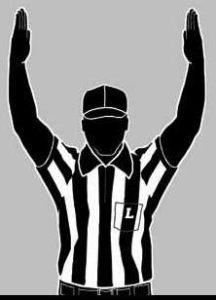
Referee Signal 5 -
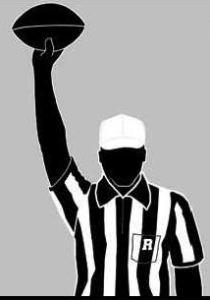
Referee Signal 14 -
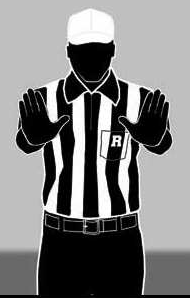
Referee Signal 33 -
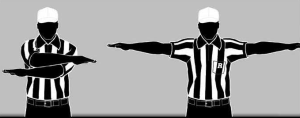
Referee Signal 10 -
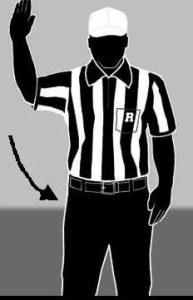
Referee Signal 52
Korrekt
 Inkorrekt
Inkorrekt

Regelquiz Flag Football für Experten
Quiz-Zusammenfassung
0 von 18 Fragen beantwortet
Fragen:
- 1
- 2
- 3
- 4
- 5
- 6
- 7
- 8
- 9
- 10
- 11
- 12
- 13
- 14
- 15
- 16
- 17
- 18
Informationen
|
Sie müssen eine E-Mail Adresse angeben. |
|
|
Sie müssen eine Text angeben. |
Informationen
Ein Quiz das sich mit dem tieferen Verständnis der Flag Football Regeln beschäftigt und etwas für erfahrene Referees ist.
Ablauf des Quiz:
- bei Multiple-Choice-Antworten gibt es mindestens eine richtige Antwort
- die Fragen und Antworten werden mit jedem Start neu gemischt
- für die Statistiker gibt es am Ende des Quiz ein Leaderboard
- Feedback kann gerne am Ende des Quiz abgegeben werden
Sie haben das Quiz schon einmal absolviert. Daher können sie es nicht erneut starten.
Quiz wird geladen...
Sie müssen sich einloggen oder registrieren um das Quiz zu starten.
Sie müssen erst folgende Quiz beenden um dieses Quiz starten zu können:
Ergebnis
0 von 18 Frage korrekt beantwortet
Ihre Zeit:
Zeit ist abgelaufen
Sie haben 0 von 0 Punkten erreicht (0)
| Ø Punkte |
|
| Deine Punkte |
|
Kategorien
- Nicht kategorisiert 0%
- contact 0%
| Platz | Name | Eingetragen am | Punkte | Ergebnis |
|---|---|---|---|---|
| Tabelle wird geladen | ||||
| Keine Daten verfügbar | ||||
- 1
- 2
- 3
- 4
- 5
- 6
- 7
- 8
- 9
- 10
- 11
- 12
- 13
- 14
- 15
- 16
- 17
- 18
- Beantwortet
- Vorgemerkt
-
Frage 1 von 18
1. Frage
Ein Receiver wird zu flach angeworfen und versucht den Ball mit dem Fuß nach oben zu kicken. Dies gelingt und er kann den Ball dadurch auch fangen. Wie ist dies zu bewerten?
Korrekt
5YD Strafe vom Basic Spot und Wiederholung des Versuchs:
Kicking the ball is intentionally striking the ball with the knee, lower leg or foot and is illegal. Rule 2 – Section 9 – Article 6Inkorrekt
5YD Strafe vom Basic Spot und Wiederholung des Versuchs:
Kicking the ball is intentionally striking the ball with the knee, lower leg or foot and is illegal. Rule 2 – Section 9 – Article 6 -
Frage 2 von 18
2. Frage
Während eines Live Balls läuft die Spielzeit ab und die Defense begeht ein Foul. Wie ist der Spielzug zu werten?
Korrekt
Ein Spiel darf nicht mit einer Strafe enden, somit muss sich die Offense entscheiden, ob sie die Strafe akzeptiert oder ablehnt:
A period shall be extended until a down has been played which is free from live ball fouls for which the penalty is
accepted. If offsetting fouls occur during a down in which time expires, the down will be repeated.
No period shall end until the ball is dead and the referee declares the period ended. Rule 3 – Section 2 – Article 2Inkorrekt
Ein Spiel darf nicht mit einer Strafe enden, somit muss sich die Offense entscheiden, ob sie die Strafe akzeptiert oder ablehnt:
A period shall be extended until a down has been played which is free from live ball fouls for which the penalty is
accepted. If offsetting fouls occur during a down in which time expires, the down will be repeated.
No period shall end until the ball is dead and the referee declares the period ended. Rule 3 – Section 2 – Article 2 -
Frage 3 von 18
3. Frage
Ein Center sieht den legalen Blitzer nicht, der Blitzer allerdings den Center. Der Blitzer weicht nicht aus, da er Right of Way (RoW) hat, und berührt den Center mit Beeinflussung. Wie ist dies zu bewerten?
Korrekt
Offsetting Penalties, d.h. der Center bekommt eine Strafe wegen Blocking und der Blitzer wegen Targeting. Beide Strafen heben sich somit auf und der Versuch wird wiederholt:
If live ball fouls by both teams are reported to the referee, the fouls offset and the down is replayed.
Exceptions:- When there is a change of team possession during a down, and the team last gaining possession had not fouled
before last gaining possession, it may decline offsetting fouls and thereby retain possession after completion of the
penalty for its foul. - When a live ball foul is administered as a dead ball foul, it does not offset and is enforced in order of occurrence.
Rule 10 – Section 2 – Article 4
Inkorrekt
Offsetting Penalties, d.h. der Center bekommt eine Strafe wegen Blocking und der Blitzer wegen Targeting. Beide Strafen heben sich somit auf und der Versuch wird wiederholt:
If live ball fouls by both teams are reported to the referee, the fouls offset and the down is replayed.
Exceptions:- When there is a change of team possession during a down, and the team last gaining possession had not fouled
before last gaining possession, it may decline offsetting fouls and thereby retain possession after completion of the
penalty for its foul. - When a live ball foul is administered as a dead ball foul, it does not offset and is enforced in order of occurrence.
Rule 10 – Section 2 – Article 4
-
Frage 4 von 18
4. Frage
Vierter Versuch bis zur Mittellinie an A’s -20YD Linie. Runner begeht an B’s +22YD Linie ein Flag Guarding und wird an B’s +10YD Linie gestoppt. Wo ist die neue Line of Scrimmage und welches Down wird gespielt?
Korrekt
Für die Festlegung eines Firstdowns gilt bei Liveballfouls nicht der Enforcement Point, sondern der Succeeding Point, d.h. durch das Flag Guarding an der +22YD Linie, wird der Ball vor die Mittelinie an die -23YD Linie gelegt. Von diesem Punkt würde der nächste Spielzug starten, da das Foul ein Loss of Down beinhaltet, wäre es der 5. Versuch für die Offense und somit wird es zu einem turnover on downs. Team B bekommt den Ball an seiner 5YD Linie und den ersten Versuch.
Inkorrekt
Für die Festlegung eines Firstdowns gilt bei Liveballfouls nicht der Enforcement Point, sondern der Succeeding Point, d.h. durch das Flag Guarding an der +22YD Linie, wird der Ball vor die Mittelinie an die -23YD Linie gelegt. Von diesem Punkt würde der nächste Spielzug starten, da das Foul ein Loss of Down beinhaltet, wäre es der 5. Versuch für die Offense und somit wird es zu einem turnover on downs. Team B bekommt den Ball an seiner 5YD Linie und den ersten Versuch.
-
Frage 5 von 18
5. Frage
Ein Defensespieler zieht aus versehen eine Flagge eines Receivers. Unmittelbar darauf wirft der QB eine Interception. Der Returner wird an der +10YD and Goallinie gestoppt. Wie lautet der Call?
Korrekt
Die Strafe wurde von der Defense vor der Interception begangen. Somit hat die Offense die Möglichkeit die Strafe zu akzeptieren: 5YD Strafe vom Basic Spot und Wiederholung des Versuchs:
If a penalty is accepted for a foul that occurred during a down before any change of team possession, the ball belongs to
the offense and the down shall be repeated, unless the penalty also involves loss of a down, mandates a first down, or
leaves the ball beyond the middle. Rule 5 – Section 2 – Article 1No player shall pull a flag from an opponent other than the runner or an opponent who simulates being the runner. Rule 9 – Section 2 – Article 2d
Inkorrekt
Die Strafe wurde von der Defense vor der Interception begangen. Somit hat die Offense die Möglichkeit die Strafe zu akzeptieren: 5YD Strafe vom Basic Spot und Wiederholung des Versuchs:
If a penalty is accepted for a foul that occurred during a down before any change of team possession, the ball belongs to
the offense and the down shall be repeated, unless the penalty also involves loss of a down, mandates a first down, or
leaves the ball beyond the middle. Rule 5 – Section 2 – Article 1No player shall pull a flag from an opponent other than the runner or an opponent who simulates being the runner. Rule 9 – Section 2 – Article 2d
-
Frage 6 von 18
6. Frage
Wo stehen die 4 Schiedsrichter initial auf dem Feld?
Sortierelemente
- Referee
- Linesman
- Field Judge
- Back Judge
-
Hinter der Line of Scrimmage und seitlich zum Field Judge im offensiven Backfield
-
Auf höhe der Line of Scrimmage an der Seitenlinie mit dem Down-Indikator
-
7YD tief an der Seitenlinie gegenüber dem Down-Indikator
-
7YD oder tiefer an der Seitenlinie auf der Seite mit dem Down-Indikator
Korrekt
Referee:
The initial position of the referee is behind and to the side of the FJ in the offensive backfield. Rule 11 – Section 2 – Article 1
Linesman:
The initial position of the linesman is on the scrimmage line at the side line with the down indicator.Rule 11 – Section 3 – Article 1
Field Judge:
The initial position of the field judge is 7 yards deep at the side line opposite to the down indicator.Rule 11 – Section 4 – Article 1
Back Judge:
The initial position of the back judge is 7 or more yards deep at the side line with the down indicator.Rule 11 – Section 5 – Article 1Inkorrekt
Referee:
The initial position of the referee is behind and to the side of the FJ in the offensive backfield. Rule 11 – Section 2 – Article 1
Linesman:
The initial position of the linesman is on the scrimmage line at the side line with the down indicator.Rule 11 – Section 3 – Article 1
Field Judge:
The initial position of the field judge is 7 yards deep at the side line opposite to the down indicator.Rule 11 – Section 4 – Article 1
Back Judge:
The initial position of the back judge is 7 or more yards deep at the side line with the down indicator.Rule 11 – Section 5 – Article 1 -
Frage 7 von 18
7. Frage
Bei einem Extrapunkt-Versuch begeht die Offense einen Blitzblock. Der Versuch wird von der +10YD Linie wiederholt. Welche Optionen hat die Offense?
Korrekt
Die Wiederholung des Extrapunkts startet an der +10YD Linie und ist außerhalb der No-Running-Zone, somit ist auch ein Lauf-Spielzug erlaubt. Eine Umentscheidung auf zwei Extrapunkte ist allerdings nicht erlaubt:
Penalties will require repeating the try or results in a score or end the try.
If the try will be repeated after a penalty, it is still worth the same value as before. No change of decision (1 or
2 points) will be made before the try ends. Rule 8 – Section 3 – Article 2e
No-Running-Zone:
When the ball is snapped on or inside the 5-yard-line going towards the opponent’s end zone (no-running-zone), the
offense has to make a forward pass play. If the quarterback or runner get deflagged behind the scrimmage line
before a forward pass play has happened, it is no penalty for a run play within the no-running-zone. Rule 7 – Section 1 – Article 3fInkorrekt
Die Wiederholung des Extrapunkts startet an der +10YD Linie und ist außerhalb der No-Running-Zone, somit ist auch ein Lauf-Spielzug erlaubt. Eine Umentscheidung auf zwei Extrapunkte ist allerdings nicht erlaubt:
Penalties will require repeating the try or results in a score or end the try.
If the try will be repeated after a penalty, it is still worth the same value as before. No change of decision (1 or
2 points) will be made before the try ends. Rule 8 – Section 3 – Article 2e
No-Running-Zone:
When the ball is snapped on or inside the 5-yard-line going towards the opponent’s end zone (no-running-zone), the
offense has to make a forward pass play. If the quarterback or runner get deflagged behind the scrimmage line
before a forward pass play has happened, it is no penalty for a run play within the no-running-zone. Rule 7 – Section 1 – Article 3f -
Frage 8 von 18
8. Frage
2. Versuch und Goalline an B’s 10YD Linie. Die Defense begeht ein Illegal Contact während des Versuchs, die Offense erzielt dennoch einen Touchdown. Wie ist der Versuch zu bewerten?
Korrekt
Sofern die Offense die Strafe nicht explizit akzeptiert und auf eine Wiederholung des Versuchs besteht, wird die Strafe auf den nächsten Versuch angerechnet, dies gilt auch für einen Extrapunkt-Versuch:
Fouls during or after a touchdown or try:- Fouls with 10 yard penalty by the no scoring team during a touchdown, enforced on the try. Other fouls are declined
by rule.
Rule 10 – Section 3 – Article 2
Inkorrekt
Sofern die Offense die Strafe nicht explizit akzeptiert und auf eine Wiederholung des Versuchs besteht, wird die Strafe auf den nächsten Versuch angerechnet, dies gilt auch für einen Extrapunkt-Versuch:
Fouls during or after a touchdown or try:- Fouls with 10 yard penalty by the no scoring team during a touchdown, enforced on the try. Other fouls are declined
by rule.
Rule 10 – Section 3 – Article 2
-
Frage 9 von 18
9. Frage
Ein Receiver fängt einen Ball stehend mit dem Rücken zum Defender, welcher sich nähert um die Flaggen zu ziehen. Dabei bleibt der Defender stehen und bekommt RoP (Right of Place). Nach dem Fangen dreht sich der Receiver an Ort und Stelle, um extra Raum zu gewinnen. Während des Drehens gibt es einen sichtbaren Kontakt mit dem Defender. Anschließend rennt der Receiver vom Defender weg und macht weiteren Raumgewinn bis dieser deflaggt wird. Wie ist dies zu bewerten?
Korrekt
Da sich der Receiver an Ort und Stelle dreht, behält dieser RoP und der Defender muss diese Drehung antizipieren, deswegen keine Strafe gegen die Offense und es geht mit dem nächsten Versuch weiter, an der der Receiver deflaggt wurde:
Right of place is given to a standing player. Standing means to remain at the spot and make no lateral movement. Rule 2 – Section 13 – Article 1Würde der Receiver aktiv einen Schritt auf den Defender zu machen, wäre dies ein Illegal Contact gegen die Offense.
Inkorrekt
Da sich der Receiver an Ort und Stelle dreht, behält dieser RoP und der Defender muss diese Drehung antizipieren, deswegen keine Strafe gegen die Offense und es geht mit dem nächsten Versuch weiter, an der der Receiver deflaggt wurde:
Right of place is given to a standing player. Standing means to remain at the spot and make no lateral movement. Rule 2 – Section 13 – Article 1Würde der Receiver aktiv einen Schritt auf den Defender zu machen, wäre dies ein Illegal Contact gegen die Offense.
-
Frage 10 von 18
10. Frage
Ein Defender drängt den Runner ohne Kontakt Richtung Auslinie. Der Runner versucht im Spielfeld zu bleiben und bleibt auf seiner Geraden, dabei berührt und beeinflusst er den Defender. Wie ist dies zu bewerten?
Korrekt
Der Runner hat mit dem Ball kein RoW und muss somit den Kontakt vermeiden, auch wenn dies bedeutet er muss abbremsen oder ggf. ins Aus gehen. Somit ein Illegal Contact gegen den Runner, 10YD Strafe vom Basic Spot und Wiederholung des Versuchs:
The runner has no right of way and is charged with avoiding contact with opponents. Rule 9 – Section 1 – Article 1eInkorrekt
Der Runner hat mit dem Ball kein RoW und muss somit den Kontakt vermeiden, auch wenn dies bedeutet er muss abbremsen oder ggf. ins Aus gehen. Somit ein Illegal Contact gegen den Runner, 10YD Strafe vom Basic Spot und Wiederholung des Versuchs:
The runner has no right of way and is charged with avoiding contact with opponents. Rule 9 – Section 1 – Article 1e -
Frage 11 von 18
11. Frage
4. Versuch und Mittellinie an A’s 9YD Linie punted der Quarterback, um den Ball los zu bekommen. Wie ist dies zu ahnden und wo geht es weiter?
Korrekt
Interpretations: AR 6-1-1
RULING: Penalty for illegal kick. The ball becomes dead, the series ends by downs and the penalty will be enforced at the next scrimmage line. 1 & middle for the opponent at the 10-yd-line.Inkorrekt
Interpretations: AR 6-1-1
RULING: Penalty for illegal kick. The ball becomes dead, the series ends by downs and the penalty will be enforced at the next scrimmage line. 1 & middle for the opponent at the 10-yd-line. -
Frage 12 von 18
12. Frage
Zweiter Versuch bis zur Mittellinie an A’s 24,5YD Linie. Der QB macht einen Schritt nach vorn (ohne die LoS zu überqueren) und streckt die Ball über die Mittellinie und kommt bis B’s 24,5YD Linie bevor die Flagge gezogen wird. Wie ist dies zu bewerten?
Korrekt
Interpretations: AR 7-1-3 I
RULING: No First Down. Penalty for illegal run. 2 & middle at the 19,5-yd-line.
NOTE: Same ruling applies at the goal line. Technically it would be an illegal run play in the no-running zone too.Inkorrekt
Interpretations: AR 7-1-3 I
RULING: No First Down. Penalty for illegal run. 2 & middle at the 19,5-yd-line.
NOTE: Same ruling applies at the goal line. Technically it would be an illegal run play in the no-running zone too. -
Frage 13 von 18
13. Frage
2. Versuch und Mittellinie an A’s -3YD Linie. Der QB wirft mittels einen Rückwärtspass den Ball aus seiner Endzone ins Aus, um einen Sack zu vermeiden. Welcher ist der nächste Versuch?
Korrekt
Interpretation AR 7-2-1 I:
RULING: No penalty, but it is a safety.When a backward pass is incomplete, the ball belongs to the passing team at the spot of the last possession, this is the
dead ball spot. Rule 7 – Section 2 – Article 3Inkorrekt
Interpretation AR 7-2-1 I:
RULING: No penalty, but it is a safety.When a backward pass is incomplete, the ball belongs to the passing team at the spot of the last possession, this is the
dead ball spot. Rule 7 – Section 2 – Article 3 -
Frage 14 von 18
14. Frage
Zwei gegnerische Spieler fangen einen Pass, während sie sich in der Luft befinden und beide landen simultan innerhalb des Spielfeldes. Wie ist das Play zu bewerten?
Korrekt
Interpretation AR 7-2-2 I
RULING: Simultaneous catch, the ball is awarded to the passing team (R 2-10-3).
NOTE: If opposing players do not return to the ground simultaneously, the player first touching the ground inbounds
with possession is awarded the completion.Inkorrekt
Interpretation AR 7-2-2 I
RULING: Simultaneous catch, the ball is awarded to the passing team (R 2-10-3).
NOTE: If opposing players do not return to the ground simultaneously, the player first touching the ground inbounds
with possession is awarded the completion. -
Frage 15 von 18
15. Frage
Ein Spieler in der Luft fängt einen Pass. Er hält den Ball sicher in den Händen und während er landet, berührt die Ballspitze zuerst und danach der Spieler den Boden. Der Spieler behält stets Kontrolle über den Ball während er innerhalb des Spielfeld landet und der Ball wird nicht lose. Wie ist der Catch zu werten?
Korrekt
Interpretation AR 7-2-2 II: Complete Pass.
A player who leaves his feet to make a catch or interception must have the ball
firmly in his possession when he first returns to the ground inbounds with any part of his body and maintain complete
and continuous control of the ball throughout the process of contacting the ground to complete a pass. If the player loses
control of the ball and the ball touches the ground before the process of the catch is complete then it is not a catch.Inkorrekt
Interpretation AR 7-2-2 II: Complete Pass.
A player who leaves his feet to make a catch or interception must have the ball
firmly in his possession when he first returns to the ground inbounds with any part of his body and maintain complete
and continuous control of the ball throughout the process of contacting the ground to complete a pass. If the player loses
control of the ball and the ball touches the ground before the process of the catch is complete then it is not a catch. -
Frage 16 von 18
16. Frage
Ein Receiver fängt den Ball in der Luft und bevor er auf dem Boden landet, wird er von einem Defender berührt und verliert dadurch die Kontrolle über den Ball. Der Ball landet auf dem Boden. Wie ist der Pass zu bewerten?
Korrekt
Interpretation AR 7-2-2 VI:
RULING: Incomplete pass and defense pass interference. The pass was not completed (R 2-10-3) and the foul occurred
while the ball was in the air.Inkorrekt
Interpretation AR 7-2-2 VI:
RULING: Incomplete pass and defense pass interference. The pass was not completed (R 2-10-3) and the foul occurred
while the ball was in the air. -
Frage 17 von 18
17. Frage
Ein Offender auf der rechten Spielfeldseite wird von einem Defender berührt (Illegal Contact) bevor der Ball vom QB geworfen wurde. Der Pass ist unvollständig auf der linken Spielfeldseite. Ist dies eine Strafe?
Korrekt
Interpretation AR 7-2-2 VI:
RULING: Illegal contact by the defense. It is a foul to contact an opponent whether the ball is thrown towards him or
not.Inkorrekt
Interpretation AR 7-2-2 VI:
RULING: Illegal contact by the defense. It is a foul to contact an opponent whether the ball is thrown towards him or
not. -
Frage 18 von 18
18. Frage
2. Versuch und Mittellinie an A’s -13YD Linie. Der Läufer verliert die Kontrolle über den Ball (Fumble) an A’s -20YD Linie. Ein Mitspieler fängt den Ball und wird an B’s +20YD Linie gestoppt. Wie ist das Play zu bewerten?
Korrekt
Interpretation AR 7-2-4 I:
RULING: Ball is dead, no penalty. Next play 3 & middle at the 20-yd-line.
NOTE: It would be the same ruling if the ball hits the ground at the 24-yd-line (forward fumble).When a fumble hits the ground or is caught by a teammate of the runner (fumbler), the ball is dead and belongs to the
fumbling team at the spot of the last possession, this is the dead ball spot. Rule 7 – Section 2 – Article 4Inkorrekt
Interpretation AR 7-2-4 I:
RULING: Ball is dead, no penalty. Next play 3 & middle at the 20-yd-line.
NOTE: It would be the same ruling if the ball hits the ground at the 24-yd-line (forward fumble).When a fumble hits the ground or is caught by a teammate of the runner (fumbler), the ball is dead and belongs to the
fumbling team at the spot of the last possession, this is the dead ball spot. Rule 7 – Section 2 – Article 4
